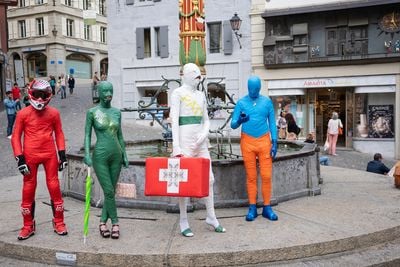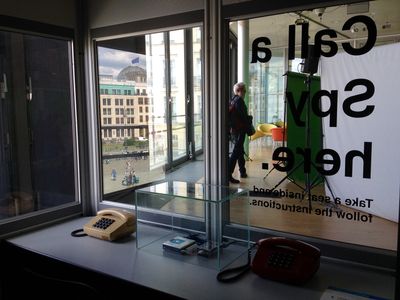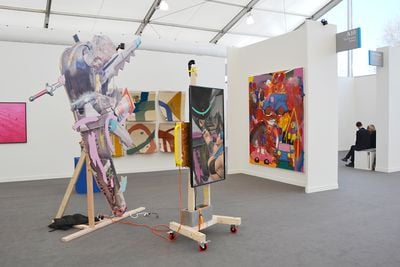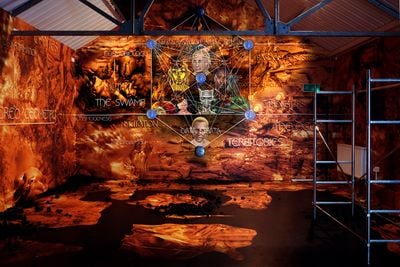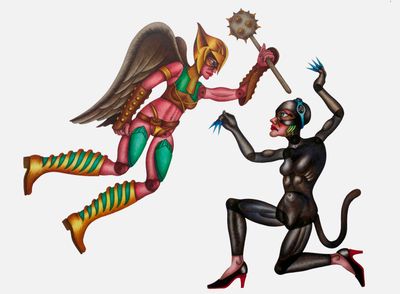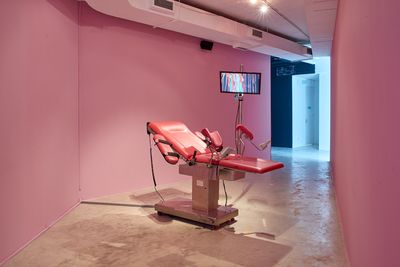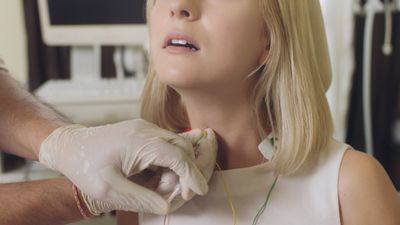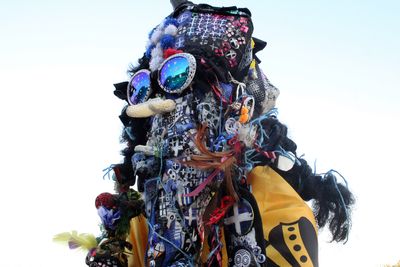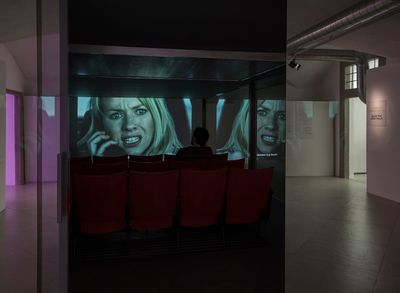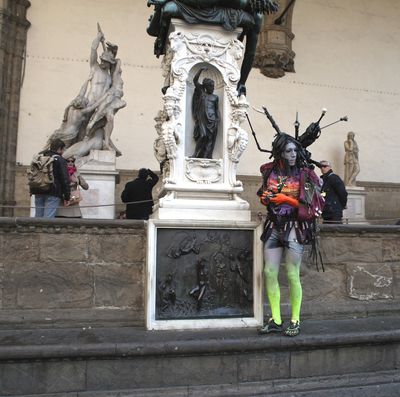Stefanie Hessler, Kostis Stafylakis and Poka-Yio on Being ANTI
Kostis Stafylakis, Stefanie Hessler and Poka-Yio. Photo: Nyssos Vassilopoulos.

Kostis Stafylakis, Stefanie Hessler and Poka-Yio. Photo: Nyssos Vassilopoulos.
In February 2007, the Athens Biennale announced its first edition, Destroy Athens, by distributing crumpled golden cards with dates and details among artists and art historians during a conference staged at the Goethe-Institut in Athens, Prayer for (Passive?) Resistance. The project seemed like a performative joke orchestrated by artist Poka-Yio, who co-founded the Biennale with curator Xenia Kalpaktsoglou and art writer Augustine Zenakos. Although all three were established figures in the local art scene, it seemed rather utopic to start a biennial exhibition from scratch in a peripheral city that did not seem exotic enough to attract a global gaze. With no long-term state policy for contemporary art or institutional support, apart from that of commercial galleries and a number of important collectors, the project seemed doomed from the start.
Nevertheless, 11 years after its launch, this do-it-yourself initiative has become one of Greece's most influential contemporary art institutions with international reach: in 2015, it was awarded the Princess Margriet Award for Culture by the European Cultural Foundation. Despite its successes, though, the Athens Biennale remains a precarious institution, since it does not have fixed funding and must seek financial support for each new edition. The Biennale's route has also coincided with one of the most turbulent periods in recent Greek history, marked by economic and refugee crises, austerity and the Indignados movement against it, the rise of the far-right, not to mention illusions and disillusions connected to the new left-wing Syriza government.
Throughout its evolution, the Athens Biennale has consistently engaged with the accelerated dynamics of crisis, and has fought against the new wave of neo-nationalism and fascism that has emerged in Greece in the past decade. Each edition, especially from 2011 and onward, has been a call for action: an invitation to think deeply about the sociopolitical situation not only in Greece and Europe, but also in the world today more broadly. More than a curatorial theme or exhibition, the institution has operated as a total artistic and social experiment predicated on a simple but crucial question: Why should a biennale exist in Athens in such times, and what should it do?
The Athens Biennale's sixth edition, taking place from 26 October to 9 December 2018, has been curated by writer and curator Stefanie Hessler, artist and theorist Kostis Stafylakis, and Poka-Yio. The curatorial theme, encapsulated in the title ANTI, explores the oppositional fervour that has come to define the contemporary social and political arena, with an emphasis on the normalisation of fascism and a post-truth turn in social media. As a whole, the curators describe ANTI as 'an ominous and subliminally dystopian show that reflects on how the conservative revolt is affecting both public and private spheres of life.' Featuring 99 artists, collectives, and theorists, a significant number of participants employ forms of subversive mimicry, maintaining a strong online presence in order to reclaim digital space from political reactionaries who are turning social media into a destructive landscape of hardening divides.
In the following conversation, the curators talk about how they are trying to challenge current reactionary dynamics in politics and culture, which is at the core of ANTI's statement.
The biennale exhibition seems to be in crisis, if not transition. What do you think could be a meaningful future for the format?
A biennale can help a local scene position itself, raise issues that garner the attention of a large and diverse international audience, and examine complicated political questions that many public museums and private institutions seldom ask. In the case of the Athens Biennale, the precariousness of the organisation has prompted its organisers and curators repeatedly to narrate the social conditions of culture and to challenge the format of periodical exhibitions.
The Athens Biennale has its own history of transforming itself into a sociopolitical device that reflects on social hardships and aggregates forces that can produce challenging views of reality. Omonoia was an attempt to mobilise urban/grassroots dynamics creating assemblies with activists, ecologists, anarchists, refugees, and other participants from all across the world. Heaven subverted the delirious image of post-Olympic games Athens, Monodrome was a reflection on de-industrialisation serving as a dark premonition of the years of crisis. Agora was a collective space of political contestation.
Considering the dismantling of institutions that is currently going on in many places around the world, and the recent instances of museum directors being sacked because they don't comply with demands of local politicians or political interests, the question of continuity is pressing. Rather than dismantling institutions that were carefully built throughout the 20th century, not to mention biennales that sprung up in the 1990s and after, we urgently need to preserve and transform such structures, and thereby give them a future.
For the forthcoming Athens Biennale, you talk about a dominant culture of opposition present in political, social and cultural life. Could you elaborate on this?
ANTI, our title, should be understood as performative. ANTI is a word-forming element, a prefix that, by using it as a title, is elevated to the status of the signifier. ANTI is not primarily meant to denote 'this' or 'that'. Rather, ANTI is meant to ignite a process of projections, interpretations, reactions, and critical reflections.
By choosing this particular prefix, we are reflecting on a number of particularly terrifying phenomena of the present, including how reactionary thinkers and movements in recent years have developed anti-status quo rhetorics and actions that have helped them usurp state, administrative and institutional power. In subtle and differentiated ways, we study the traumatic consequences of the neo-reactionary revolt on culture and society as well as its support by—and mediation through—digital communication. It's an ominous and subliminally dystopian show that reflects on how the conservative revolt is affecting both public and private spheres of life.
The Athens Biennale has a tradition of activating loaded spaces in the city that expand on the curatorial theme of each new narration, such as the former Athens Stock Exchange building that hosted Agora. What venues will frame the exhibition this year?
Our main venue is TTT, a central Athenian building that has hosted the Hellenic Telecommunications Organisation since the 1930s. The building has six floors, each of which is very different, and an overall Kafkaesque administrative architecture and interior design. The building is a symbol of the transition from analogue to digital communication—a symbol of the shift from the era of wire consoles to the early computer age and the current era of online pleasures and discomforts. It is located very centrally, near Syntagma Square. We have a few more buildings, all in close proximity. This choice signifies the centrality of ANTI in our communicative, social, political, cultural, and economic spheres.
The artist list for ANTI shows a particular focus on feminist, queer and post-internet practices that rethink design and pop culture, and use performance to investigate unconventional identities. Could you highlight some of ANTI's artistic directions?
We refer to different parts of the exhibition as devices that highlight areas of life in which opposition plays out today. These include the gym, the shopping mall, the online forum, the sex dungeon, the office, and the political front. There is a strong focus on feminist and queer practices, on absurd mimicry and overidentification as subversive strategies, and on works that reflect upon the post-internet/post-digital condition that are not ironically distant, but instead draw on research to produce unsettling manifestations of material reality with documentary character. The exhibition will at moments be quite eerie, highlighting the conundrums of our political moment, but not didactic. We don't want to create uncritical immersion or inundate viewers with even more awful sensations than they have to experience on an everyday level. The exhibition is an idiosyncratic screenshot of this particular moment, yet no purge is offered.
You have stated before that instead of assuming a position of critical detachment, the exhibition will be 'a purgatory without a purge'. What do you mean?
Many art exhibitions in recent years have attempted to create immediate action by facilitating micro-political interventions. Many of those exhibitions were very good and much needed. However, in order to not always be one step behind—that is, to react, to be against, or be ANTI—we may need to take a pause and consider what our next moves and future measures should be in a more active sense. The path we have chosen to take in this exhibition neither focuses on critically detached art, nor on art as a social service. The artists we collaborate with offer serious and speculative analyses of the current moment, and some consider strategies of how to tackle the normalisation of fascism. Many of them engage in transformative social and technological imaginations, and push those beyond their current application; like Dorota Gawęda and Eglė Kulbokaitė's Young Girl Reading Group project and their feminist and queer readings of texts and the usage of technologies. The exhibition grants room to the cognitive as well as the unconscious, the rational as well as the experiential.
Don't you think there is the danger of ANTI becoming politically reductive or—for some of the more controversial works you are showing—taken at face value? That is, to be read as leaning towards fascism?
Some might argue that we should avoid addressing reactionary tendencies and leave anti-fascist struggles to those who oppose reactionary movements on the streets. Their argument goes something like this: since irony and post-irony have become the preferred style of alt-right trolling, art has to be completely sincere and literal in its debunking of neo-reactionary tactics. This stance usually amounts to a refusal to consider reworking any part of the symbolic sphere that has been, or currently is, associated with the milieu of the alt-right. According to this logic, anti-fascist art should be reduced to declarative denunciations of reaction. We relate to the anti-fascist motivations of the people proposing this, but our approach is different. The exhibition attempts to review diverse and alternative strategies to fight the normalisation of fascism. The artworks we include in the show are neither ironic nor post-ironic.
Much of our thinking has been informed by art tactics from historical continental and Eastern European positions, as well as practices from Latin America. In post-war Europe and the USSR, for example, various artists and movements developed diverse strategies to challenge ideological cynicism and the normalisation of authoritative discourse. Thinkers such as Alexei Yurchak have analysed, for example, how Moscow conceptualists developed new strategies of humour that 'differed from sarcasm, cynicism, derision, or any of the more familiar genres of absurd humour.'1 As Yurchak suggests, it was often impossible to tell whether these interventions were forms of 'sincere support, subtle ridicule, or a peculiar mixture of the two.'2 According to Yurchak and Dominic Boyer, the strategy of overidentification with the discourse of authorities 'sent a more potent critical signal [...] than any revelatory exposé or gesture of ironic diminishment could have.'3
Correspondingly, in the late-capitalist western world of 24/7 media coverage, forms of tactical media activism have developed strategies to infiltrate neoliberal corporate and entrepreneurial discourses and cause significant disruptions in its systemic manifestations. The Yes Men and the Critical Art Ensemble are two important examples. Others include Laibach and the NSK, Eva and Franco Mattes—who are participating in the Biennale—Coco Fusco, Guillermo Gómez-Peña, Kendell Geers, and many others. In recent years, during a period of intensive crisis, similar strategies have been developed by Greek artists to oppose the normalisation of Greek nationalism, neo-patriotism, and anti-Semitism. Through mimicry and role playing, a good number of Greek artists produced 'travel agencies', 'political movements', 'scientific mockumentaries', 'fake news', 'museums dedicated to fictional historical figures', and many other devices that challenged normalised political narratives.
Such strategies, among others, can address and interact with the complexity of the present, and possibly change it. We need to continue studying the work of thinkers that build on such paradigms, for instance Inke Arns's writings on overidentification, Alexei Monroe's analysis of Laibach and the NSK, Stevphen Shukaitis on temporary hegemonic zones, Marco Deseriis on anonymity and collective authorship, autonome a.f.r.i.k.a gruppe on guerilla communication, Carrie Lambert-Beatty's research on parafictional strategies, and Ekaterina Degot's notion of unsettling mimesis.
We developed our own genres of 'unsettling mimesis' by studying and learning from international paradigms of overidentification. For instance, in the past, Poka-Yio has depicted banners of Athenian neighbourhoods marching in a neo-Nazi procession, sounding the alarm long before the Golden Dawn found its way into parliament, where it is currently nested. Kostis Stafylakis has extensively interrogated anti-Semitism in Greek public discourse and also produced mimetic iterations of Third Positionist groups.
All of these elaborate tactics can inform the ways in which we fight the normalisation of fascist ideologies and support us in reclaiming digital space from reactionaries. This is not to say that these strategies should replace anti-fascist organising or Antifa movements—but they can co-opt confrontational strategies and inform subversive tactics.
How have you incorporated strategies of mimetic reworking, parafiction, and overidentification into the Biennale?
The questions we are asking with this edition of the Biennale are: What is a good starting point for practices that wish to resist the cynical, annihilating impulses of the post-truth era? What is the most effective way to combat new reactionary subcultures that are active in forums like 4chan and disseminate fascist ideas through memes? One way to respond is to critically distance yourself, your art, and your politics from the entire milieu of social media warfare. Another way is to engage in direct activism. While many of us do so on an everyday basis, in the Biennale we put forward additional tactics. These include subversive mimetic strategies that can replace numbness, cynicism and passivity with discomfort, uneasiness and reflection. These tactics require a careful study of the recent history and methods of reactionary media and politics, as well as recent artistic practices.
The Athens Biennale, as an institutional framework that supports radical art, has a history of engaging with progressive movements and participating in theoretical discussions and artistic experimentation. Some of us grew up in Greece experiencing new waves of nationalism in the 1990s and a more recent collapse of the middle class, triggering the rise of the Golden Dawn neo-Nazis and an array of neo-patriotic movements. For us, ANTI is a device that questions the totalising narratives of the present, and responds to a need for more profound understandings and more effective tactics that can confront the urgent issues of our time. We can still do this in art.
Could you give us some examples of the different ways that the artists included in the show express opposition?
We have collaborated with over 90 artists whose practices are very diverse. Some evoke parafiction, others scrutinise today's esoteric revolt against reality and the commodification of desire; some deal with the post-human body and psyche, sabotaging the impulse of the privileged for wellness and transhumanist transgression. Others engage in storytelling, some dismantle conceptions of gender and race, and others revisit marginalised histories. In the exhibition, opposition takes different forms, at times more direct and sometimes more subtle and investigative.
For instance, Tabita Rezaire's sculpture Sugar Walls Teardom (Homage to Dark Labia) (2017) explores how bodies, and the womb especially, have been exploited historically and continue to be subjected to control exerted by the medical-legal-industrial complex. She addresses the exclusion of black women from the dominant narrative of technological progress and the simultaneous exploitation of their bodies for so-called scientific achievements. In her practice, Marianna Simnett portrays and undergoes procedures that invade the integrity of the body, often to the extent that they become unbearable to watch. Her videos, such as The Needle and the Larynx (2016) on view in the Biennale, accentuate a violence exerted by the medico-pharmaceutical apparatus upon bodies, especially female ones, as well as building on an unease surrounding cultural fears and phobias, from cockroaches to severances and diseases.
Johannes Paul Raether's Schwarmwesen (2015–ongoing) is a fictional character that he refers to as his tool, with which he generates and navigates situations in public space. Speculating on and animating future identities, this figure inserts itself in situations that involve both participants and uninvolved onlookers, raising questions of self-determination, gender and post-human futures. Joey Holder's project Adcredo—The Deep Belief Network (2018) explores the construction of belief in online networks. Holder infiltrated polarised groups and forums in social media to research the emergence of collective behaviour and the way it affects world views. For her project How does it feel to be a fiction? Athens Virus (2018), Aliza Shvarts is asking participants to become online objects for others through data collection processes, highlighting surveillance and complicity. Volunteers undergo a personality test, which triggers an email sent to all contacts in their email inbox, urging them to also take the test and thereby increasing the amount of data collected.
Panos Sklavenitis's Cargo (2018) offers a speculative post-apocalyptic, neo-folk rendition of future Greece in the form of a performance. The Front Deutscher Äpfel, a satirical anti-fascist initiative, will create a headquarter in Athens, dismantling the language, aesthetics, and mechanisms at play in popular fronts. The Peng! Collective's installation and performance Civil Financial Regulation Office (2018) interrogates European economic institutions in disarmingly sincere ways, for instance calling up the central bank to ask questions about tax breaks and austerity measures. Metahaven's lecture performance, scheduled for 24 November, scrutinises, among other things, the seduction of fake news and online users' obsessions with their own image in the myriad interfaces that surpass our reality today.
By exploring reactionary culture and politics in the social media-driven 'post-truth' era, you were accused of the exact politics that you claim to be resisting. Do you think your decision to bring together different, even reactionary, voices was too bold?
We never invited reactionary voices to the exhibition, but over 90 progressive, critical artists. The Athens Biennale is an anti-fascist space with a significant record in challenging today's reactionary ideologies, nationalism, anti-Semitism, racism as well as homophobic and misogynist stances. It's crucial to examine how this moral panic—based on the false assumption that we have reactionary artists in the show—was ignited. The flattening of actual debate and the easy dissemination of disinformation online—as well as the willingness to believe it if it sounds somewhat newsworthy and like-worthy on social media—plays a big role in this. These are the exact mechanisms of social media networks that have aided the rise of the alt-right, which we are opposing with the Biennale.
We guess that this reaction is also part of an ill-informed perspective of Greece and its art scene. For example, there is a blog post that depicts the curators of the Athens Biennale in overtly imperialist terms as middle-class hipsters. It also strangely attempts to review the Biennale before it opened or before the full artist list was even released. This is an attack against a group of artists and curators who have directly experienced the collapse of the middle class and the rise of fascism, with dramatic consequences on them and on their societal surroundings. A big question we are asking is whether we in art still find strategies to tackle urgent issues—strategies that go beyond the algorithmic, visual, and political regimes weaponised by fascist agendas.
Interestingly, the recent accusations made against the Athens Biennale have pointedly demonstrated just what we mean when we talk about how the spreading of false, post-truth information plays out today. The strategic misuse of the public sphere and the deliberate flattening of positions are not merely a questionable privilege of the reactionary right. The digital sphere, and especially social media, can also become a speculative hate machine that silences progressive voices through public distortions of their work and agenda.
With that in mind, could you sum up ANTI's intentions when it comes to resisting the flattening of discourse?
With this exhibition, we do not advocate a return to the metaphysics of truth and emancipation. As we explain in our curatorial text, we cannot decipher the post-truth era by returning to a humanism of 'truth', 'reason', and 'enlightenment'. To encounter ANTI means to spend some time reflecting on today's expressions of power and revolt without immediately aspiring to sublate or transgress them with another ANTI—even though all of us agree that we urgently need to combat fascism of all kinds. At the moment, certain artistic and critical voices demand the eradication of ambiguity and ambivalence from art. We need to pause for a moment, spend some time looking at this complex snapshot of our time and avoid regressive polemics. The fantasy that we'll fight post-truth nihilism by eradicating ambiguity from our entire communicative sphere is not only a fallacy but an attempt to destroy the very potency of art to transcend literal meaning.
The Biennale attracts tens of thousands of visitors who are not part of the art world. Considering the current political situation in most parts of the world, and especially the context in Greece, ANTI is an urgent offering of diverse progressive voices. We hope that it will inspire a wide array of tactics against fascism and bigotry of all sorts. —[O]
1 Alexei Yurchak (2005), Everything Was Forever, Until It Was No More: The Last Soviet Generation, Princeton and Oxford: Princeton University Press, p. 250.
2 Ibid.
3 Dominic Boyer & Alexei Yurchak (2010), 'American Stiob: Or, What Late-Socialist Aesthetics of Parody Reveal about Contemporary Political Culture in the West', CULTURAL ANTHROPOLOGY, Vol. 25, Issue 2, p. 182.


